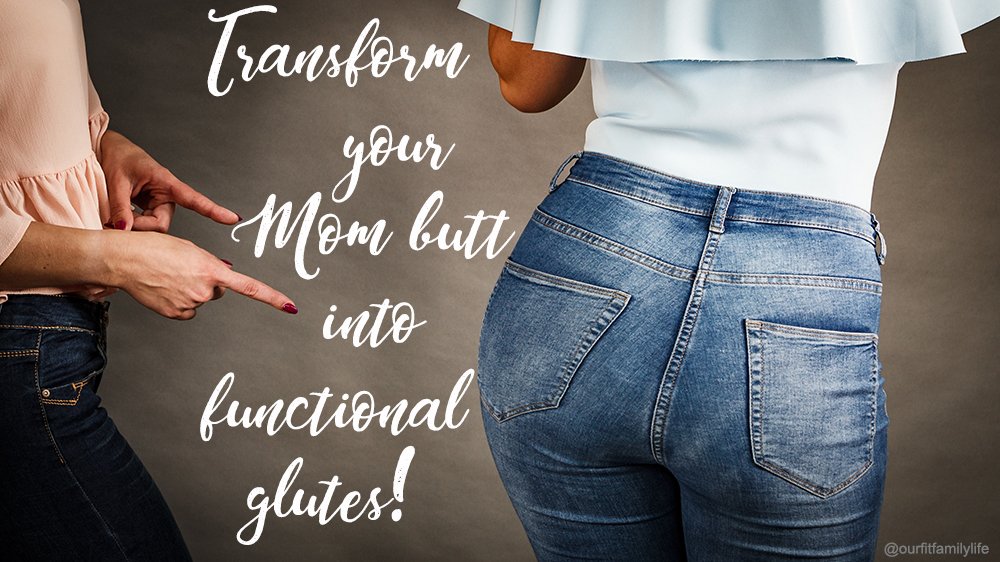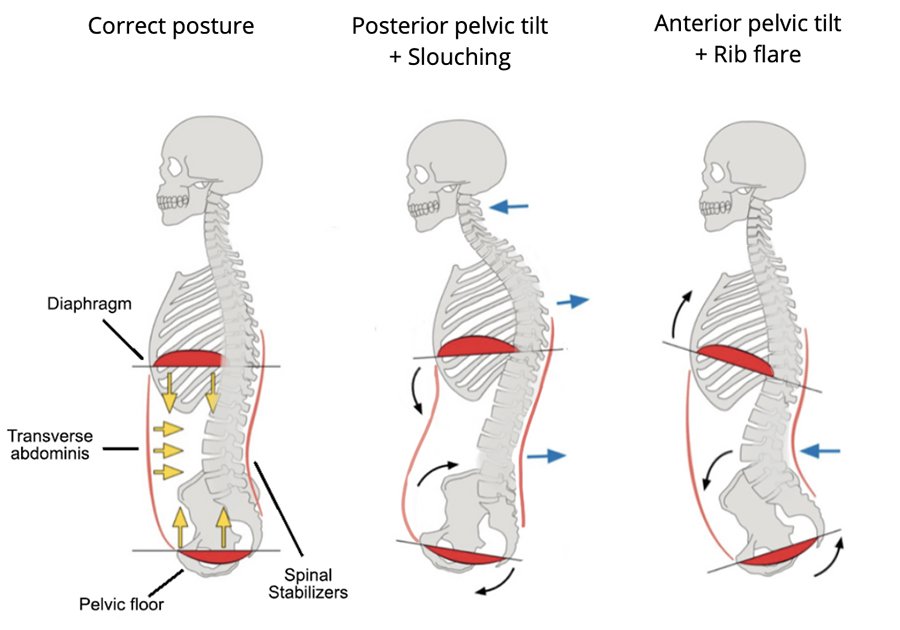Who knew motherhood could have such an effect on our bottoms?!
“Mom butt” is slang for a post-baby booty… a little saggier and a little flatter than what it used to be… This phenomenon results from muscular imbalances, and it’s not just an aesthetic issue!
The glutes work hand-in-hand with the pelvic floor and core muscles.
If you have a dramatic arch in your lower back (excessive anterior pelvic tilt), or if you tuck your tailbone and constantly clench your butt (excessive posterior pelvic tilt), then your glutes can’t fire properly, and your pelvic floor is likely not operating optimally either.
The glutes are the largest muscles in our body, and we need them to stabilize our pelvis, give us balance, and prevent core issues such as pelvic floor dysfunction, postpartum back pain, diastasis recti, and more!
8 steps to get your bum back after baby
Transform your Mom butt into functional glutes!
Most Moms tend to have poor posture and spend more time sitting/resting during pregnancy and postpartum, which results in less time using their glutes.
Postural changes and lack of activity lead to weaker and less shapely buttocks.
As the saying goes - “use it, or lose it!” - any body part that is not used as it should be eventually reduces in size and function.
“Mom butt” can be improved by a combo of actions. Let’s dig into it:
(Click on each title bellow to reveal the drop-down content)
+ Untuck & relax your glutes
#1. Functional glutes - Transform your Mom butt
This especially concerns you if you are a “butt gripper”. You could think that the tighter you squeeze or clench your glutes, the more you are working your glutes. This isn’t true!
Be mindful about your alignment and try to untuck your booty. Performing some release exercises such as cat-cow, mama squat, glute foam rolling, and stretching can help too.
+ Find your neutral position
#2. Functional glutes - Transform your Mom butt
This is essentially the halfway position between anterior and posterior tilt.
Note that everyone has a slightly different pelvic neutral due to the differences in body shape and anatomy.
The most crucial part of thinking about pelvic neutral is having your pelvis in an optimal position with your lower back not overly arched or curled.
The goal is to ensure the positioning of your pelvis and lower back are in the optimal spot for core and glute activation. Check yourself out in the mirror.
Tuck your pelvis under, then untuck it. Make a slight shift in your pelvis.
See and feel the difference, then find your neutral.
+ Improve your posture
#3. Functional glutes - Transform your Mom butt
Lengthen up!
Becoming aware of your posture and improving it can help start changing the muscle strength and size of your buttocks.
Take a look at your side profile in a mirror. From the side, it should look like a plumb line from your ears, shoulders, hips, knees, and ankles stacked up along this line.
Keep in mind that we are meant to be mobile. Therefore, frequently changing positions is recommended over staying in any one position for a long time, no matter how “good” the posture is.
+ Work on your breathing at rest
#4. Functional glutes - Transform your Mom butt
Combat stress and tension in your body.
Poor posture limits the diaphragm's ability to do its job, which could be one of the prime reasons you aren't feeling as good as you could be.
When your diaphragm doesn’t function optimally, a link in the chain becomes weak, and other body parts have to pick up the slack.
Our body is designed to allow for 360-degree diaphragmatic breathing. If you’re unsure whether you’re breathing from your diaphragm, try placing one hand on the side of your belly (above your iliac crest) and one over your chest.
The chest should remain motionless, but you should feel some movement in your stomach, sides, and lower back.
+ Restrengthen your inner core
#5. Functional glutes - Transform your Mom butt
Your glutes should not try to compensate for the lack of inner core strength, but restoring the pelvis to proper alignment involves more than “ab exercises.”
Abdominal breathing exercises should be performed to reconnect the whole core system.
You need to restrengthen and retrain the deep core muscle system. This includes the diaphragm, pelvic floor, transverse abdominis (deepest abdominal muscle), and the multifidus (deep spinal stabilisers).
+ Restrengthen your glutes
#6. Functional glutes - Transform your Mom butt
When strength training, focus on glute exercises, activating your butt muscles, rather than overusing your quads or hip flexors. Be sure to keep your awareness on your glutes and ensure they are firing properly.
Take note of your form. There is no point in doing an exercise unless you do it properly. Focusing on your form should be more important than counting reps. If you feel your form starting to slip at any point, stop, rest and reset before trying again with better form.
+ Stretch
#7. Functional glutes - Transform your Mom butt
If you have an excessive posterior pelvic tilt, there’s a good chance that the muscles in the back of your legs are too tight (hamstrings, claves).
If you have an excessive anterior pelvic tilt, there’s a good chance that the muscles in the front of your legs are too tight (hip flexors, quadriceps).
Stretching helps muscles that are chronically tight regain some flexibility and allow your body to maintain a more neutral pelvic position.
+ Move daily
#8. Functional glutes - Transform your Mom butt
Our bodies aren't designed to be seated for long periods of time; they were made to move.
Minimising the time you spend sitting is critical to rebuilding and maintaining a healthy backside.
We all know that to restrengthen or keep our muscles in shape, we need to use them.
Your glutes are a crucial part of your core system.
When it comes to getting your behind back in shape, it’s about more than liking how you look in your jeans or leggings.
Your glutes can greatly impact how your core, pelvic floor, and entire body feel and function.
Keeping them fit and functional helps those other areas stay healthy.
Here’s to strong and functional glutes!


